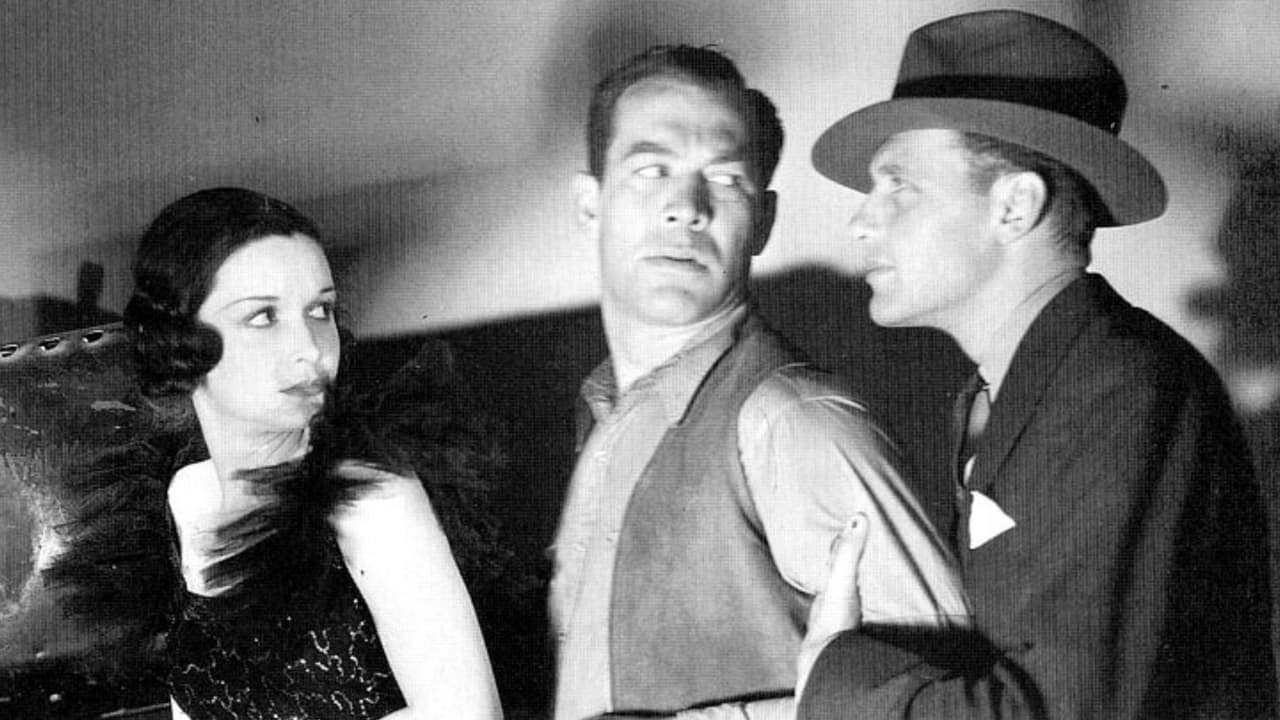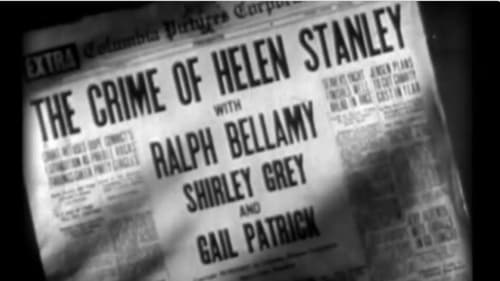


An essential item for all movie buffs, this nonsensically plotted, little "B", was extensively shot on Columbia's own sound stages, which serve as a fascinating background for much of the action, including, of course, the chase (on foot, but up and down ladders and into the scaffolding) climax. And when I say "extensively", I mean just that! The plot, as noted, is sheer drivel and doesn't make an atom of sense. But the players, with the exception of a far-too-relaxed Ralph Bellamy – who makes a most unconvincing detective – give the dopey story all the propping up it needs to keep our attention focused firmly on the screen. It also serves its purpose as an excuse to use the Columbia studio itself as a fascinating backdrop. And when our attention is focused on this backdrop rather than the dopey plot, the movie certainly has its moments particularly in its unfriendly attitude towards the film-within-the-film's director, astutely played by Lucien Prival. Harold Shumate (who was an occasional producer as well as a prolific screenwriter) modeled this rather unpleasant character on directors William Dieterle and Michael Curtiz. It's a wonder he wasn't sued (particularly as he obviously instructed Prival how to play the role)! But then, neither Dieterle nor Curtiz were noted from venturing far from their own little worlds. I'm sure that neither ever knew of The Crime of Helen Stanley. But – thanks to the VintageFilmBuff DVD – we do!
... View MoreI don't know why the 2006 reviewer from New York has never examined his analysis of "The Crime of Helen Stanley," as his depiction is for an entirely different movie (the two more recent reviewers are right on the money). This was the third of four Columbia whodunits starring Ralph Bellamy as Inspector Steve Trent, investigating homicide in a no nonsense fashion that doesn't involve comic relief, a rare approach for the 1930s (again for Columbia, he went on to emphasize the humor playing the cinema's first Ellery Queen in 1940). Gail Patrick plays the title character, a bitchy Hollywood actress who mysteriously fears for her life, protesting when her former lover takes up with her sister (Shirley Grey). Shot dead in front of the camera while twirling the dance floor, the prime suspect turns out to be her former husband, confessing his guilt before committing suicide. Inspector Trent continues his investigation, learning that the answers can all be found in the late actress' diary, which everyone would like to find. This was a Hollywood mystery along the lines of 1932's "The Death Kiss," always enjoyable to see the behind-the-scenes action in a real studio, in this case Columbia. The cast is made up of little known contract players, but there is Ward Bond, another prime suspect, and Bradley Page, always a red herring. Shirley Grey previously played opposite Boris Karloff in 1931's "The Public Defender," and a year later co-starred with Bela Lugosi in "Mystery of the Mary Celeste." Vincent Sherman, as Helen Stanley's bodyguard, later became better known as a director (1939's "The Return of Doctor X"), while Steven Chase, as the suicidal ex, played the doomed doctor devoured by "The Blob" in 1958. The first Trent feature was "Before Midnight" (1933), also just as good, the second, "One is Guilty," rather elusive, the last, "Girl in Danger," a weak finale. Ralph Bellamy's sterling career continued right up until his death in 1991.
... View MoreMaybe there are two "Crime of Helen Stanley" movies, but the one reviewed is not the one I saw. It was also remade as "Who Killed Gail Preston" (1938) with Rita Hayworth.Lee Davis (Kane Richmond), cameraman for Tru Art Studio is all set to marry Betty (Shirley Gray) but when Helen Stanley ("I'm Helen Stanley - people do as I say in Hollywood, I'm a star!!!) (Gail Patrick) walks in on them, she makes her position clear - "I made you and I can break you!!! She is worried about her safety, though, and consults Inspector Trent (Ralph Bellamy). Before he can do anything, she is killed - on the set, playing a scene from her new movie. It looks like an open and shut case, the actor who is supposed to have "shot" her has disappeared but Trent discovers the bullet did not come from the same gun. The actor, Wallach, is convinced he is the killer and kills himself - it turns out that Wallace was Helen's husband - they had married twelve years before.Along with Lee, there are the usual suspects - Stanley's manager, George (Bradley Page), who is holding $60,000 in trust for her and is reluctant to give it up. Almost as unpleasant as Helen, is the autocratic director, Gibson (Lucien Prival), who people hate just as much as they do Helen. He had met Helen in Vienna three years before and she helped him get a job in Hollywood and a visa - but he has overstayed his welcome!!! Betty's revelation is that she was Helen's sister - all of them are searching for a diary which Helen kept hidden away. Betty finds it but is knocked out by ...Karl (Vincent Sherman) the chauffeur, who has just found a new job. Jack (Ward Bond) finds out the secret to Helen Stanley's murder but is killed while telephoning Inspector Trent. The scene is set for a recreation of the murder - the movie has some great behind the scenes action at a film studio (Columbia). Very similar in it's appeal to "The Death Kiss" (1932). Ralph Bellamy made a series of films in which he appeared as Inspector Trent (others include "One is Guilty" (1934), "Girl in Danger" (1934)). Gail Patrick was one of many who entered the "Panther Girl" competition that Paramount ran to find an up and coming actress for their film "The Island of Lost Souls" (1932). Probably the only actress who didn't become a success was the eventual winner, Kathleen Burke. After an impressive part as an ambitious singer in "The Phantom Broadcast" (1933) and a few other roles as she was learning her craft, Gail was then cast as the snooty Hollywood star, Helen Stanley. Shirley Grey was a competent actress who polished her talent during the twenties in several theatrical productions. She managed to break into films in 1930, but because of her blonde prettiness, she was mostly cast as the dewy eyed heroine and "The Crime of Helen Stanley" was no exception.Recommended.
... View MoreBlue-eyed Betty Lane runs away from home after she learns the shocking truth about her father's womanizing. A chance meeting with her old finishing school classmate, dark-eyed and seductive Helen Stanley, leads Betty to the tangled mysteries of the Gothic Stanley mansion in the deep south.This crime thriller handles themes of race prejudice, drug addiction, insanity, family secrets, and even lesbian sex. Betty stumbles across letters from Helen's father confessing that beautiful pale-skinned Helen is really the daughter of a light skinned black woman. Sweet, trusting Betty would never do anyone any harm, but strong-willed Helen has been raised in the brutal world of Jim Crow. She will do anything to protect her identity as a "white" woman.Shirley Gray does a great job showing Betty's sweet, trusting nature, her fear melting into relief as Helen laughs and offers to "spin the bottle" with her. But this kissing game is not about innocent romance. Helen "spins" a long ivory opium pipe, laughing and teasing until shy Betty reluctantly takes her first puff. Gail Patrick, dark eyed and very beautiful, shows the wolfish side to Helen Stanley's deeds. Her eyes light up as Betty sucks on the long ivory pipe, plainly seeing that the blue-eyed blonde is heading for helpless addiction.Once Betty is on the pipe, Helen converts her into a pet, or slave. The two of them host parties where Southern gentlemen paw the increasingly oblivious Betty, who clings to Helen like a lost child, begging for "another puff, Helen. Please! Just a quick one." Soon Betty is weeping, begging for more of the drug, and a laughing Helen kicks her out into the rain.At this point, well into the film, we cut to Inspector Trent, the "hero" of the film, who has been building a file on Helen for months. He rescues Betty, exposes the drug ring, and watches as a doomed Helen dies in the flames of her father's plantation house. But the final line of the film, "this is the way it has to be," has a dark, ambiguous meaning. Is Trent upholding justice or the racial code of the Deep South? For all her cruelty and evil, Helen is far more attractive than Betty, whose sweet, submissive nature is spineless and fundamentally passive. She ends the movie clinging to Inspector Trent just as helplessly as she clung to Helen! The Inspector's line to her -- "a baby like you needs a lot of looking after," is also hard to fathom. Does he love her, or did he secretly love evil Helen? Altogether, a fascinating lost film of the Thirties crime genre!
... View More